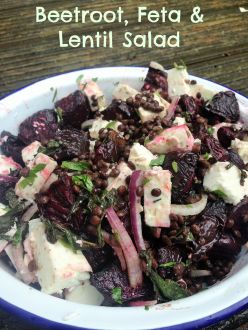Since the Bakehouse has taken more of my time, I’ve spent less time at the allotment than I had been (and probably less than I should). With sightly less baking and teaching to do, I’ve managed to grab some moments to hit the plot and enjoy an open air lunch. There’s nothing better than a picnic, and having you’re own bit of ‘countryside’ to sit in and relax with a meal is brilliant. Packed lunches; whether taken to the allotment, in a picnic basket, or eaten at work; needn’t be boring. They shouldn’t be an excuse for an unhealthy mishmash of packets either. It takes very little effort to produce something which is both healthy and delicious.
I recently got contacted by the team from Simply Health, who were looking for some healthy packed lunch ideas. I like to use allotment produce, so a salad using the newest of beetroot and fresh herbs seemed a good idea. I love the earthy sweetness of the anti-oxidant rich beets, and teamed with the saltiness of a cheese like feta, its perfect for a summer packed lunch. Lentils are brilliant for salads, adding bite and a good source of protein and carbohydrates.
Beetroot, Feta and Lentil Salad
You will need (serves 2)
A bunch of beetroot
200g green lentils (Puy lentils are the best as they retain their bite the best)
Bay leaf
200g feta or similar cheese
4 tbsp olive oil
1 tbsp cider vinegar
1 tsp Dijon mustard
pinch of salt and a few twists of black pepper
Start by trimming the beetroot of the leaves (which if young can make a great salad), then cut into bite size chunks. Toss in a little olive oil and roast in a hot oven for 3o-40mins, until the beets are soft and slightly charred. Remove from the roasting tray and retain the beetrooty oil to make the dressing. Whilst the beetroot roasts, place the lentils in cold water with a bay leaf and bring to the boil; you can now get pre cooked lentils in packs, which saves time on this, but I like to always have a supply of lentils cooked and in the fridge, so cooking from scratch allows me to make more than I need. Lentils need about 25mins to cook, but check after 20 as its important they retain a bit of bite. Once ready, drain, and make the dressing by combining the retained oil, mustard, vinegar, and seasoning. With the lentils still warm, pour the dressing into them and stir, allowing the lentils to absorb some of the dressing’s flavour.
To prepare the salad, combine the lentils and beetroot, along with the finely chopped mint. Crumble the feta into this mix, before gently stirring the ingredients to ensure that every mouthful includes all the flavours. If you wanted, you could add salad leaves at this point (something peppery like watercress would go well), but I like the earthy nature of this salad as it is. Pop the completed salad in a sealable container and take it on your travels, to work, or (like me) to the allotment. Just remember a spoon or fork to eat it with!



















 Apples, and specifically British apples, are my favourite fruit. I love the variety in flavours that apples bring, from sweet and juicy, to crisp and sharp. I think that there is no better apple than a British one, so always have a self-imposed break from apples once the supplies of home-grown fruit runs out. I don’t see the point in importing foods which we grow so well anyway. Seasonality also has the advantage of allowing my palate to enjoy the plethora of other fruits available, and truly appreciate the first apple of the year. We have a really early apple tree (Beauty of Bath), so the first apple of the season is always one of our own and munched during the summer holidays. But, whether Cox, Russet, Windsor, Bramley, or any other of the 1,900 different varieties of apple trees held at the
Apples, and specifically British apples, are my favourite fruit. I love the variety in flavours that apples bring, from sweet and juicy, to crisp and sharp. I think that there is no better apple than a British one, so always have a self-imposed break from apples once the supplies of home-grown fruit runs out. I don’t see the point in importing foods which we grow so well anyway. Seasonality also has the advantage of allowing my palate to enjoy the plethora of other fruits available, and truly appreciate the first apple of the year. We have a really early apple tree (Beauty of Bath), so the first apple of the season is always one of our own and munched during the summer holidays. But, whether Cox, Russet, Windsor, Bramley, or any other of the 1,900 different varieties of apple trees held at the 














